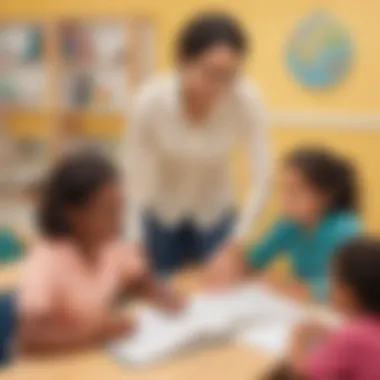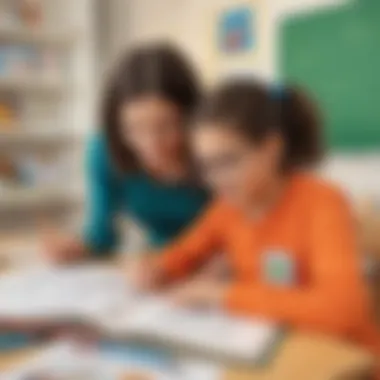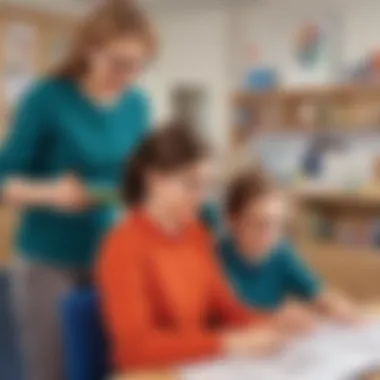Strategies for Crafting Effective Lesson Plans for Students with Special Needs


Interactive Learning Games
Educational Topics
As educators and parents strive to optimize lesson plans for special needs students, curating educational topics across various subjects becomes pivotal. Compiling articles that cover subjects like math, science, languages, and more ensures a diverse and comprehensive approach to interdisciplinary learning. Emphasizing the importance of interdisciplinary learning for holistic development highlights the significance of a well-rounded education that addresses different aspects of a child's growth.
Tips and Tricks
Within the realm of special needs education, providing practical tips for parents and educators becomes instrumental in enhancing children's learning journey. Strategies that focus on making learning fun and engaging hold immense value in keeping children motivated and enthusiastic about their educational pursuits. By offering creative and adaptable suggestions, parents and educators can effectively support special needs students in their learning endeavors.
Creative DIY Projects
Craft Ideas
Curating a collection of creative craft ideas using simple household items enhances artistic expression within a special needs learning environment. Recognizing the significance of artistic expression in children's development sheds light on how these projects can foster creativity and self-expression. Encouraging children to engage in art-based activities contributes to their overall cognitive and emotional growth, making it a valuable addition to lesson plans.
Understanding Special Needs Education
Defining Special Needs
The term 'special needs' encompasses a wide spectrum of educational requirements arising from diverse disabilities. These may include physical, cognitive, emotional, or behavioral challenges that hinder a student's learning process. Understanding these distinct needs is imperative for educators to provide appropriate support and tailored lesson plans that cater to individual requirements.
Challenges Faced by Special Needs Students
Intellectual Disabilities
Intellectual disabilities pose unique challenges for special education. Individuals with intellectual disabilities often experience difficulties in areas such as cognitive functioning, conceptual understanding, and adaptive behaviors. Despite these challenges, individuals with intellectual disabilities possess strengths in areas like creativity, empathy, and resilience. In the context of this article, addressing the educational needs of students with intellectual disabilities is crucial for fostering a holistic learning environment.


Physical Impairments
Physical impairments can present obstacles to a student's participation in educational activities. These impairments may include mobility limitations, chronic health conditions, or sensory impairments, affecting a student's ability to engage fully in the learning process. Implementing inclusive practices that accommodate physical impairments is essential for creating a supportive and accessible learning environment.
Sensory Processing Disorders
Sensory processing disorders can significantly impact a student's sensory experiences, affecting how they perceive and respond to stimuli in their environment. Students with sensory processing disorders may demonstrate sensory seeking or sensory avoiding behaviors, requiring tailored approaches to address their individual needs. By recognizing and accommodating these challenges, educators can create sensory-friendly learning environments that promote student learning and engagement.
Importance of Tailored Lesson Plans
Tailored lesson plans play a pivotal role in special education to address the diverse needs of students effectively. By customizing instructional strategies, learning materials, and assessments, educators can create individualized education programs that cater to the unique abilities and challenges of each student. Tailored lesson plans not only enhance student engagement and comprehension but also foster a sense of inclusivity and support within the learning community.
Creating Effective Lesson Plans
When it comes to special needs education, creating effective lesson plans is an essential component that can significantly impact the academic progress and overall development of students. In the context of this article, 'Creating Effective Lesson Plans' plays a crucial role in optimizing learning experiences for special needs students by tailoring instruction to meet their unique requirements. By focusing on individualized learning objectives and strategies, educators can address the diverse needs of students with varying abilities and challenges.
Individualized Education Programs (IEPs)
Individualized Education Programs (IEPs) are personalized plans developed for students with special needs to outline their specific learning goals, support services, and accommodations. These tailored programs ensure that each student receives the necessary assistance and resources to achieve academic success. Educators collaborate with parents, specialized staff, and the students themselves to create IEPs that address their individual strengths and challenges. IEPs provide a roadmap for implementing customized teaching strategies and monitoring the student's progress towards their educational objectives.
Differentiated Instruction Techniques
Differentiated instruction techniques are essential in catering to the diverse learning needs of special education students. By adjusting content, modifying assignments, and providing additional support, educators can engage students effectively and enhance their comprehension and retention of material.
Adjusting Content
Adjusting content involves customizing the curriculum to match the learning styles and pace of individual students. This tailored approach allows educators to present information in a clear and accessible manner, catering to the specific needs of each student. By adapting the content to align with students' interests and abilities, teachers can promote active engagement and foster a positive learning experience.
Modifying Assignments


Modifying assignments involves adapting tasks and activities to suit the skills and preferences of special needs students. By offering assignments that are challenging yet achievable, educators can promote skill development and academic growth. This approach ensures that students are appropriately challenged and supported in their learning journey.
Providing Additional Support
Providing additional support encompasses offering extra assistance, resources, and guidance to students who require supplemental help to thrive academically. This may include one-on-one tutoring, visual aids, or technology-based tools to enhance learning outcomes. By providing tailored support, educators can address the unique needs of special education students and facilitate their progress towards academic success.
Utilizing Assistive Technology
Incorporating assistive technology in lesson planning can significantly benefit special needs students by enhancing accessibility, engagement, and comprehension. Assistive technology tools such as interactive apps, adaptive software, and communication devices can provide students with alternative ways to access information and demonstrate their understanding. By integrating assistive technology into lesson plans, educators can create inclusive and supportive learning environments that empower students to succeed.
Incorporating Inclusive Learning Methods
In the realm of special education, the topic of Incorporating Inclusive Learning Methods stands as a pivotal element within the overall framework of this article. Understanding the significance of creating a learning environment that embraces diversity and inclusivity is paramount when catering to the unique needs of special needs students. By implementing inclusive learning methods, educators can promote a sense of belonging and support academic growth for all learners, regardless of their abilities or challenges. This section delves into the specific elements, benefits, and considerations associated with Incorporating Inclusive Learning Methods, shedding light on the essential strategies that drive positive learning outcomes in special education settings.
Collaborative Learning Opportunities
Collaborative Learning Opportunities within the context of special education exemplify the power of student interaction and shared learning experiences. By fostering collaboration among students with varying abilities, educators can cultivate a rich learning environment that promotes peer-to-peer support, fosters social skills development, and encourages an inclusive classroom culture. Collaborative learning offers students the opportunity to engage with their peers, exchange ideas, and work together towards common academic goals. This approach not only enhances academic outcomes but also nurtures a sense of community and mutual respect within the classroom.
Peer Support Strategies
Peer Support Strategies play a vital role in fostering a supportive and inclusive learning environment for special needs students. Within this section, the focus is on two key aspects: Buddy Systems and Peer Mentoring. ## Buddy System provide students with a designated peer partner who offers assistance, encouragement, and companionship throughout the academic journey. This one-on-one support system enhances social connections, builds trust, and boosts confidence levels among students, leading to improved academic performance and emotional well-being. On the other hand, ## r Mentoring## in es older students or peers guiding and supporting their counterparts in various academic and social activities. This reciprocal relationship fosters leadership skills, empathy, and a sense of camaraderie, creating a holistic support network within the classroom.
Encouraging Participation and Engagement
Encouraging Participation and Engagement is a fundamental aspect of creating an inclusive learning environment for special needs students. By promoting active participation and interaction among all learners, educators can enhance student motivation, foster social integration, and improve overall learning outcomes. Strategies such as interactive activities, inclusive group projects, and adaptive teaching methods can empower students to voice their thoughts, share their unique perspectives, and actively engage in the learning process. Encouraging participation not only boosts student confidence but also promotes a culture of inclusivity and diversity in the classroom, setting the stage for meaningful educational experiences.
Assessing Student Progress and Adaptations


In the realm of special education, assessing student progress and adaptations plays a pivotal role in ensuring the academic growth and development of students with diverse needs. This section of the article delves into the significance of effectively monitoring, adjusting, and collaborating to provide a tailored educational experience that caters to the specific requirements of each student.
Monitoring Academic Growth
When it comes to monitoring academic growth, educators need to implement comprehensive strategies that go beyond traditional assessment methods. This involves tracking not only the student's academic achievements but also their social and emotional progress. By adopting a holistic approach to monitoring, teachers can gain a deeper insight into the overall well-being of the student and identify areas that may require additional support or intervention.
Adjusting Lesson Plans Accordingly
Regular Feedback
Regular feedback is a cornerstone of effective teaching for special needs students. It involves providing consistent and constructive feedback to students on their performance, progress, and areas for improvement. Regular feedback helps students stay on track, boosts their confidence, and facilitates better understanding of their strengths and weaknesses. In the context of this article, regular feedback fosters a supportive learning environment that values continuous improvement and individualized growth.
Revision of Goals
The process of revising goals is essential in adapting lesson plans to meet the changing needs of special education students. Setting realistic and attainable goals initially is important, but being flexible and willing to adjust these goals is equally crucial. By revising goals based on ongoing assessment and feedback, educators can ensure that students are continuously challenged while receiving the necessary support. This adaptive approach to goal setting promotes resilience, perseverance, and personal growth among students, aligning perfectly with the theme of this article.
Implementing Multisensory Teaching Approaches
Visual, Auditory, and Kinesthetic Techniques
In the context of special education, employing visual, auditory, and kinesthetic techniques plays a pivotal role in facilitating meaningful learning experiences. Visual aids help students process information through images, diagrams, and videos, making abstract concepts more tangible and accessible. Incorporating auditory elements, such as music or verbal instructions, assists students with auditory learning preferences in retaining information effectively. Kinesthetic techniques involve hands-on activities and movement, allowing students to interact with the material physically, enhancing their understanding and engagement in the learning process.
Hands-On Learning Activities
Experiential Learning
Experiential learning is a valuable approach that immerses students in hands-on experiences to connect theoretical knowledge with real-world applications. This method encourages active participation, critical thinking, and problem-solving skills among special needs students. The hands-on nature of experiential learning promotes experiential learning fosters creativity, boosts confidence, and facilitates a deeper understanding of concepts. While experiential learning requires resources and planning, its benefits in promoting practical skills and academic growth make it a favorable choice for enhancing the educational journey of special needs students.
Manipulatives
Manipulatives, tangible objects used to represent abstract concepts, are instrumental in promoting interactive and engaging learning experiences. By physically manipulating objects such as blocks, counters, or puzzles, students can internalize complex ideas, improve fine motor skills, and enhance spatial awareness. The tactile nature of manipulatives caters to varied learning styles, reinforcing concepts through hands-on exploration and visual-motor coordination. While manipulatives offer tangible learning experiences, they may require supervision and resources for implementation, but their effectiveness in fostering understanding and engagement in special needs education is noteworthy.
Creating Sensory-Friendly Environments
Creating sensory-friendly environments is essential in optimizing the learning environment for special needs students. Teachers must consider factors such as lighting, noise levels, and sensory stimuli to create a space conducive to learning. By incorporating calming colors, minimizing distractions, and providing sensory tools, educators can support students with sensory sensitivities and create a comfortable and inclusive learning environment that promotes focus, participation, and emotional well-being.















